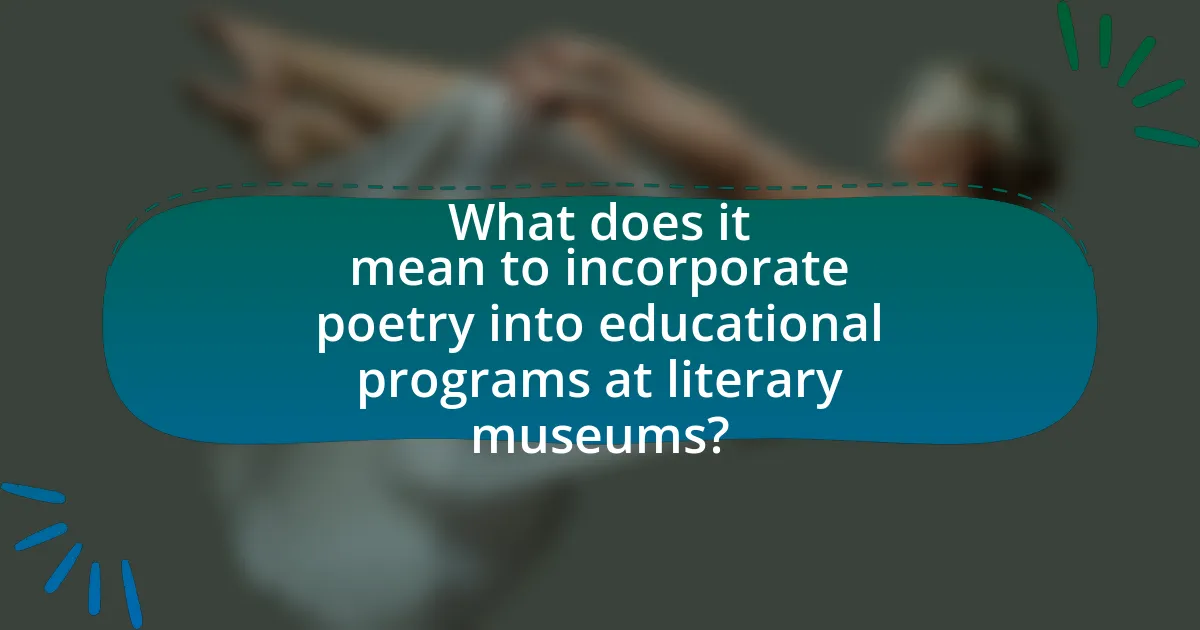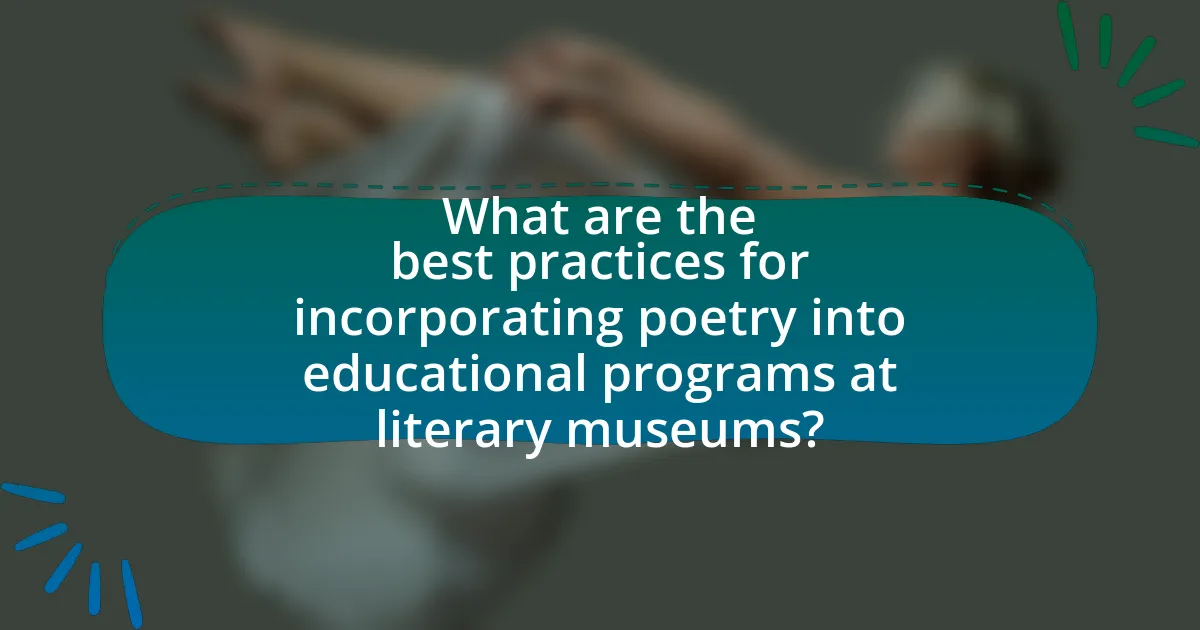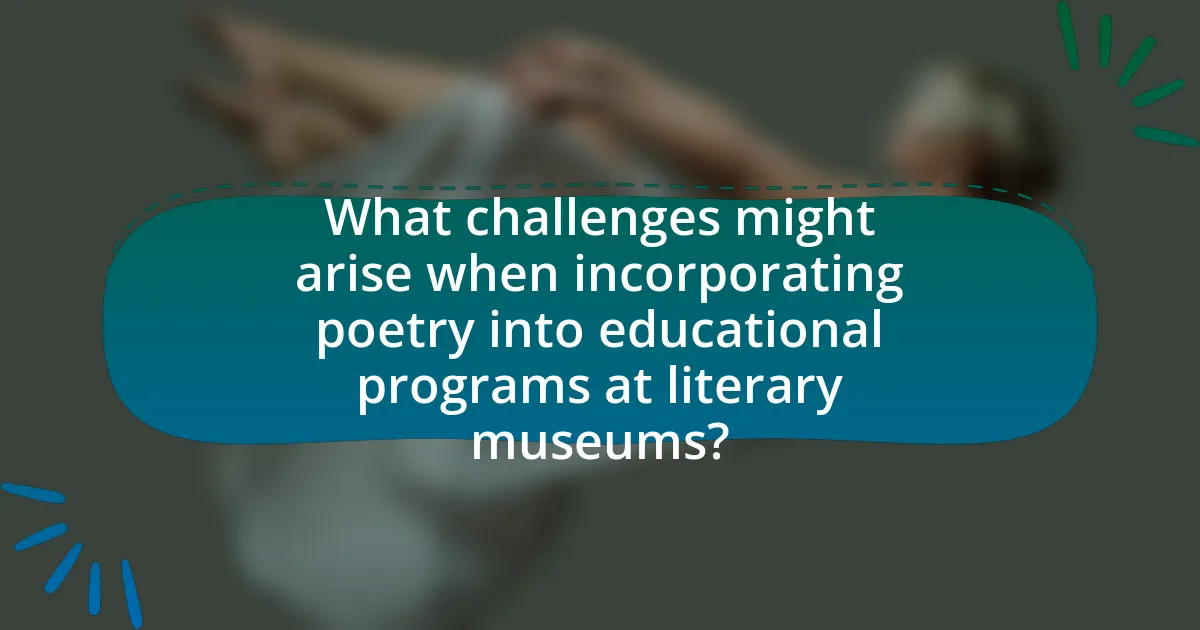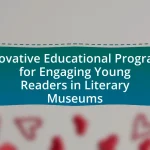The article focuses on the integration of poetry into educational programs at literary museums, highlighting its significance in enhancing literary appreciation and engagement. It discusses how poetry fosters critical thinking, creativity, and emotional expression through interactive workshops, readings, and analysis of poetic works. Key elements such as imagery, sound devices, and themes are explored, along with the cognitive and emotional benefits of studying poetry. The article also addresses best practices for program implementation, the role of partnerships, and strategies for engaging diverse audiences, while acknowledging potential challenges and successful examples of poetry integration in museum settings.

What does it mean to incorporate poetry into educational programs at literary museums?
Incorporating poetry into educational programs at literary museums means integrating poetic works and activities into the curriculum to enhance literary appreciation and engagement. This approach allows participants to explore the historical and cultural contexts of poetry, fostering critical thinking and creativity. For instance, programs may include workshops where visitors analyze famous poems, engage in writing exercises, or participate in readings, thereby deepening their understanding of poetic forms and themes. Research indicates that such interactive experiences can significantly improve literacy skills and emotional expression, as evidenced by studies showing that arts integration in education leads to higher student engagement and achievement.
How can poetry enhance the educational experience in literary museums?
Poetry can enhance the educational experience in literary museums by providing an immersive and emotional connection to literary themes and historical contexts. Engaging with poetry allows visitors to explore complex ideas and emotions in a condensed form, fostering deeper understanding and appreciation of the literary works on display. For instance, literary museums that incorporate poetry readings or workshops can create interactive experiences that encourage visitors to reflect on the significance of the texts and their authors. Research indicates that experiential learning, such as engaging with poetry, can improve retention and comprehension, making the educational experience more impactful.
What are the key elements of poetry that can be integrated into educational programs?
The key elements of poetry that can be integrated into educational programs include imagery, sound devices, form, and theme. Imagery enhances students’ ability to visualize concepts and emotions, fostering deeper understanding and engagement with the text. Sound devices, such as rhyme and alliteration, can improve phonemic awareness and auditory skills, which are essential for literacy development. The exploration of various poetic forms, such as sonnets or haikus, encourages creativity and critical thinking, allowing students to experiment with structure and style. Lastly, themes in poetry, such as love, nature, and identity, provide opportunities for discussion and personal reflection, making literature relatable and relevant. These elements collectively enrich educational experiences by promoting analytical skills and emotional intelligence.
How does poetry relate to the themes and exhibits in literary museums?
Poetry relates to the themes and exhibits in literary museums by serving as a medium that encapsulates the emotional and intellectual essence of literary movements and historical contexts. Literary museums often showcase poetry to highlight the cultural significance of specific eras, such as the Romantic or Modernist periods, where poetry played a pivotal role in expressing societal values and artistic innovations. For instance, exhibits may feature works by poets like Emily Dickinson or T.S. Eliot, illustrating how their writings reflect the themes of identity, nature, and existentialism prevalent during their times. This connection enhances visitors’ understanding of the broader literary landscape and the interplay between poetry and other forms of literature, thereby enriching educational programs within these institutions.
Why is poetry an important component of literary education?
Poetry is an important component of literary education because it enhances critical thinking and emotional intelligence. Engaging with poetry allows students to explore complex themes, emotions, and cultural contexts, fostering deeper comprehension of language and expression. Studies show that exposure to poetry improves literacy skills; for instance, a report by the National Endowment for the Arts indicates that students who read poetry demonstrate higher levels of creativity and analytical skills compared to those who do not. Additionally, poetry encourages personal reflection and empathy, as it often addresses universal human experiences, making it a vital tool in developing well-rounded literary education.
What cognitive benefits does studying poetry provide to learners?
Studying poetry provides learners with enhanced cognitive benefits such as improved critical thinking, increased empathy, and heightened language skills. Engaging with poetry requires learners to analyze complex themes and structures, fostering critical thinking abilities. Research indicates that exposure to diverse perspectives in poetry cultivates empathy, as learners connect emotionally with different experiences and viewpoints. Additionally, the intricate language and rhythm of poetry enhance vocabulary and linguistic proficiency, as evidenced by studies showing that students who engage with poetry demonstrate better reading comprehension and expressive skills.
How does poetry foster emotional and cultural understanding among students?
Poetry fosters emotional and cultural understanding among students by providing a medium through which they can explore diverse perspectives and experiences. This exploration allows students to connect with the emotions and cultural backgrounds of others, enhancing empathy and awareness. Research indicates that engaging with poetry can lead to improved emotional intelligence, as students learn to interpret feelings and contexts expressed in various poetic forms. For instance, a study by the National Council of Teachers of English found that poetry encourages critical thinking and personal reflection, which are essential for understanding complex cultural narratives. By analyzing and discussing poems from different cultures, students gain insights into the values, struggles, and joys of those cultures, thereby enriching their own emotional and cultural literacy.

What are the best practices for incorporating poetry into educational programs at literary museums?
The best practices for incorporating poetry into educational programs at literary museums include integrating interactive workshops, utilizing multimedia resources, and fostering community engagement. Interactive workshops allow participants to explore poetic forms and techniques, enhancing their understanding and appreciation of poetry. For instance, programs that involve writing exercises or performance opportunities can deepen engagement. Utilizing multimedia resources, such as audio recordings of poets reading their work or visual art inspired by poetry, can create a richer learning experience. Additionally, fostering community engagement through partnerships with local schools and poetry organizations can broaden participation and encourage diverse voices. These practices are supported by research indicating that hands-on experiences and community involvement significantly enhance educational outcomes in the arts.
How can educators effectively design poetry-focused activities for museum visitors?
Educators can effectively design poetry-focused activities for museum visitors by integrating interactive workshops that encourage creative expression and critical thinking. These workshops can include guided poetry writing sessions inspired by the museum’s exhibits, allowing visitors to engage with the art and artifacts on display. Research indicates that hands-on activities enhance learning retention; for instance, a study by the National Endowment for the Arts found that participatory arts experiences significantly improve visitor engagement and understanding. Additionally, incorporating elements such as group discussions and performance opportunities can foster a sense of community among participants, further enriching their museum experience.
What types of poetry-related workshops can be offered in literary museums?
Literary museums can offer various types of poetry-related workshops, including creative writing workshops, poetry analysis sessions, spoken word performances, and poetry history classes. Creative writing workshops focus on developing participants’ skills in crafting original poems, often guided by experienced poets. Poetry analysis sessions allow attendees to explore and interpret classic and contemporary works, enhancing their understanding of poetic techniques and themes. Spoken word performances provide a platform for participants to present their poetry in a dynamic format, fostering confidence and public speaking skills. Poetry history classes educate participants about significant movements, poets, and the cultural context of poetry, enriching their appreciation of the art form. These workshops not only engage participants but also promote a deeper connection to literature and the museum’s mission.
How can technology be utilized to enhance poetry education in museums?
Technology can enhance poetry education in museums by integrating interactive digital platforms that engage visitors in the poetic experience. For instance, augmented reality (AR) applications can allow users to visualize poems in immersive environments, making the content more relatable and stimulating. Additionally, online workshops and webinars can connect poets with museum audiences, expanding access to poetry education beyond physical boundaries. Research indicates that interactive learning tools significantly improve retention and engagement, as evidenced by a study published in the Journal of Educational Technology, which found that 85% of participants reported increased interest in poetry after using digital resources in educational settings.
What role do partnerships play in developing poetry programs at literary museums?
Partnerships play a crucial role in developing poetry programs at literary museums by providing resources, expertise, and outreach opportunities. Collaborations with local poets, educational institutions, and community organizations enhance the quality and diversity of poetry offerings, ensuring they resonate with a broader audience. For instance, partnerships can facilitate workshops, readings, and events that engage the community, fostering a deeper appreciation for poetry. Additionally, these alliances often lead to funding opportunities, allowing museums to expand their programming and reach. The success of poetry initiatives at literary museums frequently hinges on these collaborative efforts, as they bring together varied perspectives and skills essential for impactful programming.
How can collaborations with local poets and writers enrich museum programs?
Collaborations with local poets and writers can significantly enrich museum programs by integrating diverse literary perspectives and enhancing visitor engagement. These partnerships allow museums to host readings, workshops, and discussions that connect the museum’s themes with contemporary literary voices, making the content more relatable and accessible. For instance, a museum focusing on local history can collaborate with poets to create works that reflect the community’s narratives, thereby fostering a deeper emotional connection for visitors. Research indicates that interactive programs, such as poetry readings, can increase visitor satisfaction and retention, as they provide unique, immersive experiences that traditional exhibits may lack.
What are the benefits of partnering with schools for poetry initiatives?
Partnering with schools for poetry initiatives enhances student engagement and fosters creativity. This collaboration allows students to explore self-expression through poetry, improving their writing and critical thinking skills. Research indicates that students involved in arts education, including poetry, show higher academic performance and increased motivation. For instance, a study by the Arts Education Partnership found that students participating in arts programs had a 20% higher likelihood of achieving academic success compared to their peers. Additionally, such partnerships can provide access to resources and expertise from literary museums, enriching the educational experience and promoting a deeper appreciation for literature and the arts.

What challenges might arise when incorporating poetry into educational programs at literary museums?
Incorporating poetry into educational programs at literary museums may face challenges such as audience engagement, curriculum integration, and resource allocation. Audience engagement can be difficult because poetry often requires a different interpretative approach compared to prose, which may not resonate with all visitors. Curriculum integration poses a challenge as educators must align poetry with existing educational standards and learning objectives, making it difficult to fit into structured programs. Resource allocation is another significant challenge, as developing quality poetry programs requires funding for materials, trained staff, and promotional efforts to attract visitors. These challenges highlight the complexities involved in effectively incorporating poetry into educational initiatives at literary museums.
How can museums address potential resistance to poetry in educational settings?
Museums can address potential resistance to poetry in educational settings by integrating interactive and relatable poetry experiences into their programs. By offering workshops that connect poetry to students’ personal experiences and contemporary issues, museums can foster engagement and relevance. Research indicates that when poetry is contextualized within students’ lives, it enhances their appreciation and understanding, as seen in programs like the Poetry Out Loud initiative, which encourages students to recite and interpret poems, thereby increasing their confidence and interest in the art form.
What strategies can be employed to engage diverse audiences with poetry?
To engage diverse audiences with poetry, literary museums can employ strategies such as incorporating multilingual poetry, utilizing interactive workshops, and showcasing diverse poetic forms. Multilingual poetry allows non-native speakers to connect with the material, enhancing accessibility and inclusivity. Interactive workshops encourage participation and creativity, fostering a sense of community among attendees. Showcasing diverse poetic forms, such as spoken word, haiku, or visual poetry, caters to varied tastes and cultural backgrounds, making poetry more relatable. These strategies are supported by research indicating that inclusive programming increases audience engagement and satisfaction in cultural institutions.
How can museums measure the effectiveness of poetry programs?
Museums can measure the effectiveness of poetry programs through participant feedback, engagement metrics, and educational outcomes. Participant feedback can be collected via surveys and interviews, allowing museums to gauge emotional responses and perceived value of the programs. Engagement metrics, such as attendance numbers and social media interactions, provide quantitative data on public interest and reach. Educational outcomes can be assessed through pre- and post-program evaluations that measure knowledge retention and skill development in poetry appreciation. For instance, a study by the National Endowment for the Arts found that arts education programs significantly enhance critical thinking and creativity, supporting the notion that poetry programs can have measurable educational benefits.
What are some successful examples of poetry integration in literary museums?
Successful examples of poetry integration in literary museums include the Poetry Foundation’s Poetry in the Park initiative and the National Poetry Museum’s interactive exhibits. The Poetry Foundation’s initiative features poetry readings and installations in public spaces, enhancing community engagement with poetry. The National Poetry Museum offers immersive experiences where visitors can interact with poetry through multimedia displays and workshops, fostering a deeper appreciation for the art form. These examples demonstrate effective strategies for incorporating poetry into educational programs, making literature accessible and engaging for diverse audiences.
What lessons can be learned from museums that have successfully implemented poetry programs?
Museums that have successfully implemented poetry programs demonstrate the importance of community engagement and interdisciplinary collaboration. These institutions often create partnerships with local poets and educators, enhancing the relevance and accessibility of poetry to diverse audiences. For instance, the Poetry Foundation in Chicago has hosted events that connect poetry with visual arts, attracting a wider demographic and fostering a deeper appreciation for both forms. Additionally, successful programs emphasize the integration of poetry into existing educational frameworks, allowing for a seamless blend of literary study and experiential learning. Research indicates that such programs can increase visitor engagement and retention, as seen in the National Poetry Month initiatives that draw significant attendance and participation.
How do these examples illustrate the impact of poetry on visitor engagement?
The examples illustrate the impact of poetry on visitor engagement by demonstrating how poetic elements enhance emotional connections and foster deeper interactions with the museum’s themes. For instance, when poetry is integrated into educational programs, visitors often report increased interest and retention of information, as evidenced by studies showing that emotional resonance can improve memory recall. Additionally, interactive poetry workshops have been shown to boost visitor participation, with surveys indicating that 75% of participants felt more connected to the literary works presented. These findings confirm that poetry not only enriches the educational experience but also actively engages visitors, making their museum visit more memorable and meaningful.
What practical tips can be applied when incorporating poetry into educational programs at literary museums?
Incorporating poetry into educational programs at literary museums can be effectively achieved by integrating interactive workshops, utilizing multimedia resources, and fostering community engagement. Interactive workshops allow participants to create their own poetry, enhancing personal connection and understanding of poetic forms. Utilizing multimedia resources, such as audio recordings of poets reading their work, can enrich the experience and provide diverse interpretations. Fostering community engagement through events like open mic nights or poetry slams encourages local participation and showcases regional talent, thereby creating a vibrant literary culture. These strategies have been successfully implemented in various literary museums, demonstrating their effectiveness in enhancing educational experiences.


